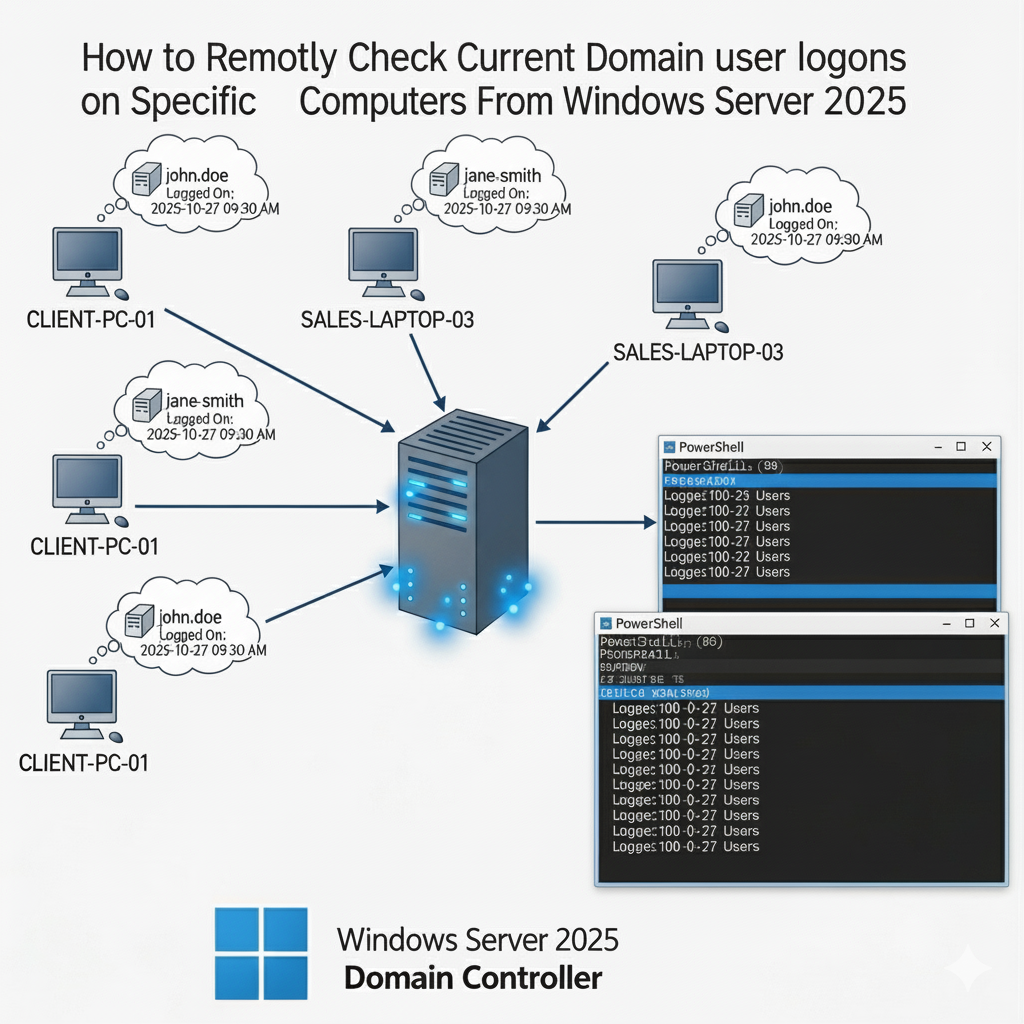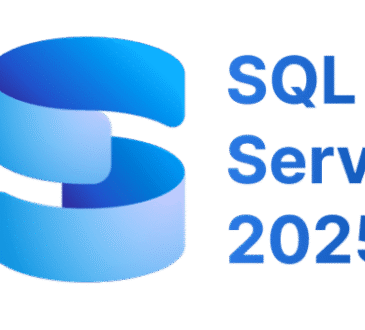How to Remotely Check Current Domain User Logons on Specific Computers From Windows Server 2025 Domain Controller

Managing user sessions across a Windows domain environment is a critical administrative task. As system administrators, we often need to identify which users are currently logged into specific computers within our domain. Windows Server 2025 provides several robust methods to accomplish this remotely from the domain controller. This comprehensive guide explores the most effective techniques and tools available.
Prerequisites
Before implementing these methods, ensure you have:
- Administrative privileges on the domain controller
- Appropriate permissions to query remote computers
- Network connectivity between the domain controller and target machines
- Windows PowerShell (preferably version 5.1 or later)
- Remote management enabled on target computers
Method 1: Using PowerShell Get-WmiObject
PowerShell remains one of the most versatile tools for remote system administration. The Get-WmiObject cmdlet can query Win32_ComputerSystem class to retrieve current user information.
Get-WmiObject -Class Win32_ComputerSystem -ComputerName "TARGET-PC" | Select-Object UserName
Enhanced Script with Error Handling
function Get-CurrentDomainUser {
param(
[Parameter(Mandatory=$true)]
[string]$ComputerName
)
try {
$computerSystem = Get-WmiObject -Class Win32_ComputerSystem -ComputerName $ComputerName -ErrorAction Stop
if ($computerSystem.UserName) {
Write-Host "Current user on $ComputerName : $($computerSystem.UserName)" -ForegroundColor Green
} else {
Write-Host "No user currently logged in to $ComputerName" -ForegroundColor Yellow
}
}
catch {
Write-Host "Failed to connect to $ComputerName : $($_.Exception.Message)" -ForegroundColor Red
}
}
# Usage example
Get-CurrentDomainUser -ComputerName "WORKSTATION-01"
Method 2: Using CIM Cmdlets (Recommended for Windows Server 2025)
CIM (Common Information Model) cmdlets are the modern replacement for WMI cmdlets, offering better performance and reliability.
Get-CimInstance -ClassName Win32_ComputerSystem -ComputerName "TARGET-PC" | Select-Object UserName, Name
Advanced CIM Implementation
function Get-DomainUserLogon {
param(
[Parameter(Mandatory=$true, ValueFromPipeline=$true)]
[string[]]$ComputerName,
[PSCredential]$Credential
)
process {
foreach ($Computer in $ComputerName) {
try {
$sessionParams = @{
ComputerName = $Computer
ErrorAction = 'Stop'
}
if ($Credential) {
$sessionParams.Credential = $Credential
}
$session = New-CimSession @sessionParams
$computerInfo = Get-CimInstance -CimSession $session -ClassName Win32_ComputerSystem
[PSCustomObject]@{
ComputerName = $Computer
CurrentUser = $computerInfo.UserName
Domain = $computerInfo.Domain
Status = 'Online'
Timestamp = Get-Date
}
Remove-CimSession $session
}
catch {
[PSCustomObject]@{
ComputerName = $Computer
CurrentUser = 'N/A'
Domain = 'N/A'
Status = 'Offline/Error'
Timestamp = Get-Date
Error = $_.Exception.Message
}
}
}
}
}
# Usage with multiple computers
$computers = @("PC-01", "PC-02", "PC-03")
$results = $computers | Get-DomainUserLogon
$results | Format-Table -AutoSize
Method 3: Using Query User Command
The traditional query user command can be executed remotely to show all active user sessions.
query user /server:TARGET-PC
PowerShell Wrapper for Query User
function Get-UserSessions {
param(
[Parameter(Mandatory=$true)]
[string]$ComputerName
)
try {
$sessions = query user /server:$ComputerName 2>$null
if ($sessions) {
Write-Host "Active sessions on $ComputerName :" -ForegroundColor Cyan
$sessions | ForEach-Object { Write-Host $_ }
} else {
Write-Host "No active sessions found on $ComputerName" -ForegroundColor Yellow
}
}
catch {
Write-Host "Unable to query $ComputerName : $($_.Exception.Message)" -ForegroundColor Red
}
}
Method 4: Using Event Log Analysis
For historical logon data and detailed session information, Windows Event Logs provide comprehensive insights.
function Get-LogonEvents {
param(
[Parameter(Mandatory=$true)]
[string]$ComputerName,
[int]$Hours = 24
)
$startTime = (Get-Date).AddHours(-$Hours)
try {
$events = Get-WinEvent -ComputerName $ComputerName -FilterHashtable @{
LogName = 'Security'
ID = 4624 # Successful logon
StartTime = $startTime
} -ErrorAction Stop
$events | ForEach-Object {
$eventXml = [xml]$_.ToXml()
$userData = $eventXml.Event.EventData.Data
[PSCustomObject]@{
TimeCreated = $_.TimeCreated
UserName = ($userData | Where-Object {$_.Name -eq 'TargetUserName'}).'#text'
Domain = ($userData | Where-Object {$_.Name -eq 'TargetDomainName'}).'#text'
LogonType = ($userData | Where-Object {$_.Name -eq 'LogonType'}).'#text'
SourceIP = ($userData | Where-Object {$_.Name -eq 'IpAddress'}).'#text'
}
}
}
catch {
Write-Error "Failed to retrieve events from $ComputerName : $($_.Exception.Message)"
}
}
Method 5: Using Active Directory PowerShell Module
Leverage the Active Directory module for domain-wide queries and computer management.
Import-Module ActiveDirectory
function Get-DomainComputerUsers {
param(
[string]$SearchBase = (Get-ADDomain).DistinguishedName,
[string]$Filter = "*"
)
$computers = Get-ADComputer -Filter $Filter -SearchBase $SearchBase
foreach ($computer in $computers) {
try {
$currentUser = Get-CimInstance -ComputerName $computer.Name -ClassName Win32_ComputerSystem -ErrorAction Stop
[PSCustomObject]@{
ComputerName = $computer.Name
CurrentUser = $currentUser.UserName
LastLogon = $computer.LastLogonDate
OperatingSystem = $computer.OperatingSystem
Enabled = $computer.Enabled
}
}
catch {
[PSCustomObject]@{
ComputerName = $computer.Name
CurrentUser = "Unable to connect"
LastLogon = $computer.LastLogonDate
OperatingSystem = $computer.OperatingSystem
Enabled = $computer.Enabled
}
}
}
}
Comprehensive Monitoring Script
Here’s a complete solution that combines multiple methods for robust monitoring:
function Start-DomainUserMonitoring {
param(
[Parameter(Mandatory=$true)]
[string[]]$ComputerNames,
[int]$RefreshInterval = 300, # 5 minutes
[string]$LogPath = "C:\Admin\UserLogons.csv"
)
Write-Host "Starting domain user monitoring..." -ForegroundColor Green
Write-Host "Monitoring computers: $($ComputerNames -join ', ')" -ForegroundColor Cyan
Write-Host "Refresh interval: $RefreshInterval seconds" -ForegroundColor Cyan
while ($true) {
$results = @()
foreach ($computer in $ComputerNames) {
try {
# Primary method: CIM
$computerInfo = Get-CimInstance -ComputerName $computer -ClassName Win32_ComputerSystem -ErrorAction Stop
$result = [PSCustomObject]@{
Timestamp = Get-Date -Format "yyyy-MM-dd HH:mm:ss"
ComputerName = $computer
CurrentUser = $computerInfo.UserName
Domain = $computerInfo.Domain
Status = 'Online'
Method = 'CIM'
}
}
catch {
# Fallback method: Query User
try {
$queryResult = query user /server:$computer 2>$null
$status = if ($queryResult) { 'Online-QueryUser' } else { 'No Sessions' }
$result = [PSCustomObject]@{
Timestamp = Get-Date -Format "yyyy-MM-dd HH:mm:ss"
ComputerName = $computer
CurrentUser = if ($queryResult) { "Multiple/Console" } else { "None" }
Domain = "Unknown"
Status = $status
Method = 'QueryUser'
}
}
catch {
$result = [PSCustomObject]@{
Timestamp = Get-Date -Format "yyyy-MM-dd HH:mm:ss"
ComputerName = $computer
CurrentUser = "N/A"
Domain = "N/A"
Status = 'Offline/Error'
Method = 'Failed'
}
}
}
$results += $result
Write-Host "$($result.Timestamp) - $($result.ComputerName): $($result.CurrentUser)" -ForegroundColor $(
switch ($result.Status) {
'Online' { 'Green' }
'No Sessions' { 'Yellow' }
default { 'Red' }
}
)
}
# Log results
$results | Export-Csv -Path $LogPath -Append -NoTypeInformation
Start-Sleep -Seconds $RefreshInterval
}
}
# Usage
$targetComputers = @("WORKSTATION-01", "WORKSTATION-02", "SERVER-01")
Start-DomainUserMonitoring -ComputerNames $targetComputers -RefreshInterval 180
Conclusion
Windows Server 2025 provides multiple robust methods for remotely checking domain user logons. The CIM cmdlets offer the best combination of performance and reliability, while PowerShell scripting enables automation and comprehensive monitoring solutions. By implementing these techniques with proper error handling and security considerations, administrators can maintain effective oversight of user sessions across their domain environment.
Remember to test these methods in your specific environment and adjust the scripts according to your security policies and network configuration. Regular monitoring of user logons not only aids in troubleshooting but also enhances security by providing visibility into user activity across your domain infrastructure.



![Windows Server 2025 LTSC [10.0.26100.7171] Version 24H2 4 Windows Server 2025 LTSC [10.0.26100.7171] Version 24H2](https://vmorecloud.com/wp-content/uploads/2025/12/Windows-Server-2025-365x330.jpg)

